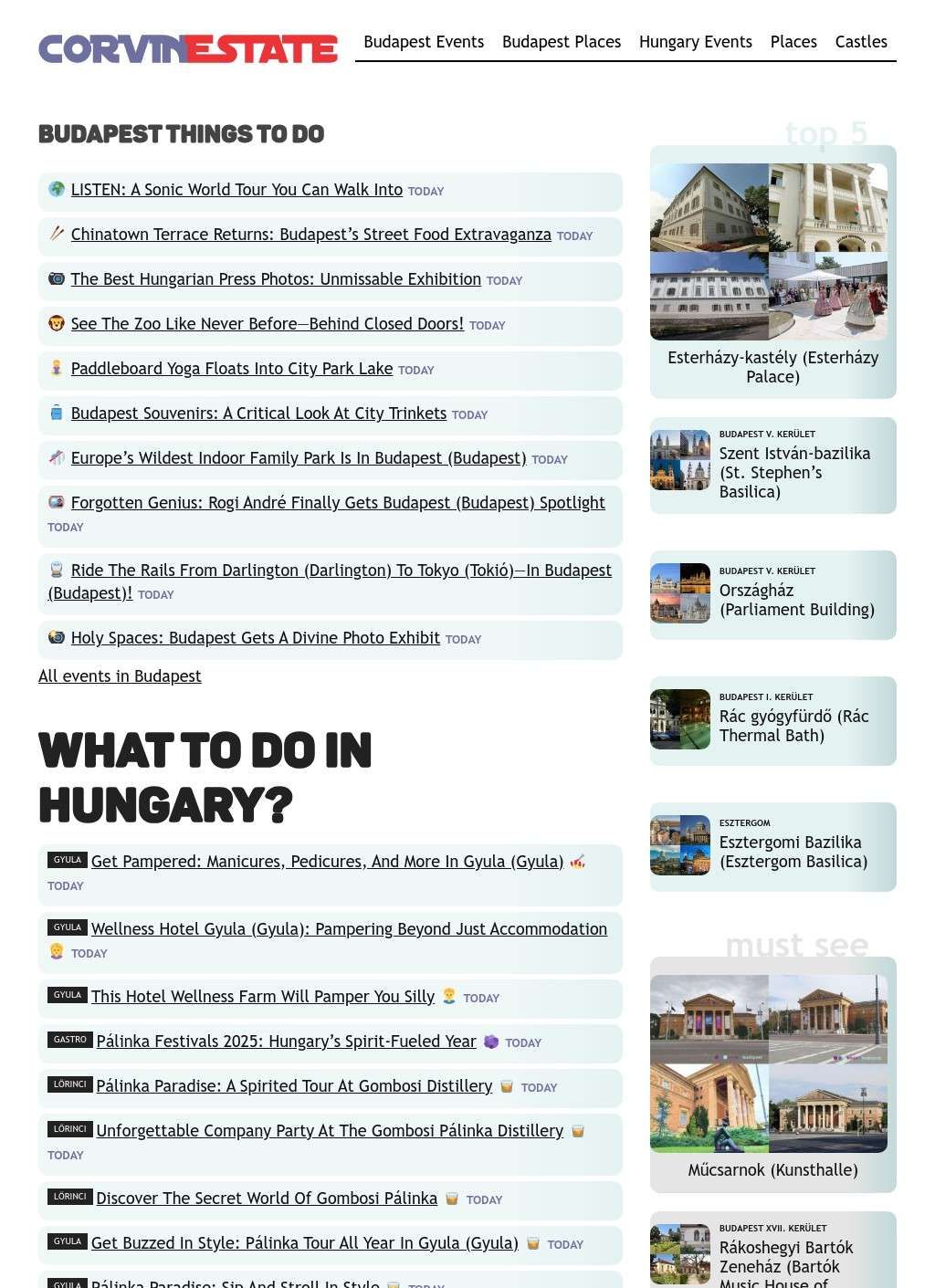Corvin Estate operates as a comprehensive Hungary travel guide website, providing detailed information about tourist destinations, cultural attractions, and events throughout the country. The platform serves as an informational resource for travelers interested in exploring Hungary, offering extensive coverage of sites ranging from Budapest's major landmarks to lesser-known regional attractions. With content dating back to 2006 according to their copyright notice, the website has established itself as a long-standing resource for those planning visits to Hungary or seeking to discover the country's diverse cultural and historical offerings.
The website's content structure focuses on destination-based information, featuring detailed articles about specific attractions across Hungary's major regions. Coverage spans from Budapest's iconic sites like St. Stephen's Basilica and the Parliament Building to regional treasures such as the Déri Museum in Debrecen, the Zsolnay Cultural Quarter in Pécs, and the wine cellars of Tokaj. Each attraction receives thorough treatment with descriptive narratives that go beyond basic tourist information, offering context about historical significance, architectural features, and cultural importance. The writing style tends toward the literary, with evocative descriptions that paint vivid pictures of each location rather than just listing facts.
Geographic coverage encompasses Hungary's diverse regions, from the capital Budapest to smaller towns and rural areas. The website features content about major cities like Pécs, known for its Ottoman heritage and UNESCO World Heritage sites, Debrecen with its Great Reformed Church, and tourist favorites like Szentendre's old town and the Lake Balaton region. Thermal spa destinations receive particular attention, including locations in Lenti and Balatonfüred, reflecting Hungary's famous spa culture. The platform also covers specialized attractions like the Skanzen Open-Air Museum, various Orthodox churches, and unique sites such as the Goat Church in Sopron, demonstrating attention to both mainstream and off-the-beaten-path destinations.
The website's organizational approach includes both thematic categorization and geographic mapping of attractions. A visual map interface allows users to see the locations of various sites across Hungary, with blue markers indicating programs or events and red markers showing permanent attractions. This mapping feature helps travelers understand the spatial relationships between different sites and plan efficient itineraries. The content appears regularly updated with current events, as evidenced by mentions of contemporary activities like paddleboard yoga in Budapest's City Park Lake, suggesting ongoing maintenance rather than static archival content.
Unlike commercial travel platforms that focus on bookings or tour sales, Corvin Estate appears to operate primarily as an informational resource without obvious monetization through direct bookings or tour packages. The website doesn't display pricing information, booking capabilities, or tour operator partnerships. Instead, it functions more like an extensive travel blog or guide, providing rich descriptive content that helps travelers understand what each destination offers. This approach positions it as a discovery tool for independent travelers who prefer to make their own arrangements rather than purchasing packaged tours.
The writing quality suggests professional travel writing rather than user-generated content or basic tourist board descriptions. Articles demonstrate deep local knowledge, incorporating historical context, architectural details, and cultural nuances that would appeal to travelers seeking more than surface-level tourist information. The tone balances informative content with engaging narrative, making the descriptions both educational and entertaining. Writers clearly have familiarity with the sites they describe, offering insights about atmosphere, local quirks, and visitor experiences that go beyond what typical guidebooks provide.
While the website lacks visible contact information, social media links, or about pages that would clarify its ownership or editorial team, the consistent quality and comprehensive coverage suggest professional curation rather than amateur blogging. The domain name "Corvin Estate" likely references the historic Corvin Castle in Romania, though the website focuses exclusively on Hungarian destinations. This naming choice might indicate historical or cultural connections, though the exact reasoning isn't explained on the visible pages.
The platform serves multiple traveler demographics through its diverse content selection. Cultural enthusiasts find detailed information about museums, churches, and historical sites. Adventure seekers discover thermal spas, aquaparks, and outdoor activities. Wine tourists get insights into regions like Tokaj with its famous cellars. Architecture buffs can explore everything from medieval castles to Ottoman mosques to Baroque churches. This broad appeal makes the website useful for various travel styles, from quick city breaks in Budapest to extensive cultural tours across multiple Hungarian regions. The depth of coverage for each attraction suggests the site targets travelers who value understanding and context over simple logistics, positioning it as a resource for thoughtful tourism rather than quick sightseeing.
